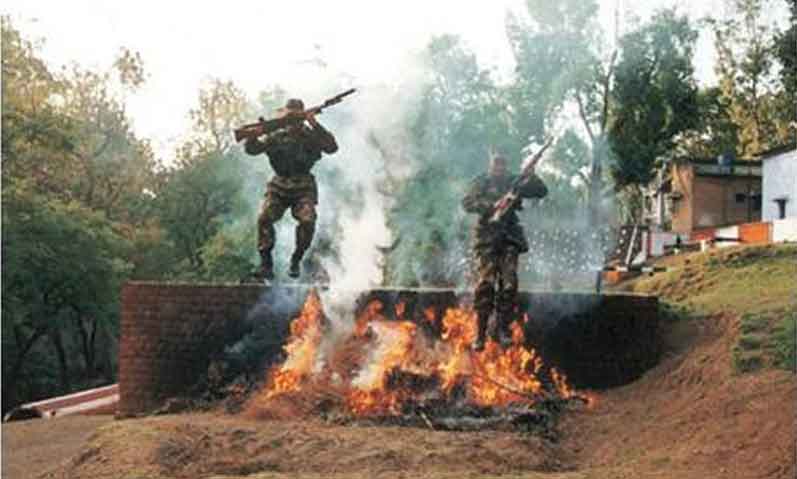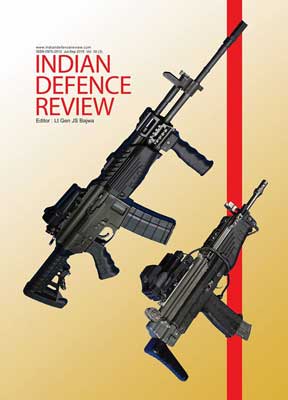From the beginning of the new century, the economic environment in India has rapidly improved despite the downturn of the last couple of years and our inability to live up to our potential. With an increasingly assertive and powerful China and a receding United States, there has been increasing pressure on India from the US, Japan and the other Asian nations to work in tandem with them to counter the former. However, a disjointed and poorly executed programme to enhance infrastructure along the Sino-Indian border has left India vulnerable with limited conventional ability to react against Chinese designs especially since infrastructure in Tibet has seen quantum improvement. While attempts are now underway to rectify the situation, it will take time for India to achieve conventional deterrence.
“If a man does not keep pace with his companions, perhaps it is because he hears a different drummer.” —Thoreau
Policy paralysis in the Indian Government brought military modernisation to a complete halt…
Just as the nuclear bombardment of Hiroshima and Nagasaki changed the very nature of conflict and ushered in deterrence as a benchmark in strategic thought for the West and the Soviet Union, so too can be said for the Indian state with the demonstration of its status as a nuclear power at Pokhran.
This and India’s economic rise from the beginning of this century have greatly impacted Indian strategic thought and military doctrine. While the global community was required to come to terms with the events of September 11, 2001, and America’s Global War on Terror, India had already been deeply affected by the perfidy of Kargil in 1999 and what subsequent success in that conflict implied.
However, the economic meltdown of 2008 led to diminishing US influence in Asia which was sought to be filled by China. Policy paralysis in the Indian Government brought military modernisation to a complete halt and reduced India’s influence in the region, as rapidly evolving events in the Maldives and Sri Lanka have shown. India’s inability to respond to growing Chinese aggression and hegemonistic ambitions has only added to her woes.
We again find ourselves at the crossroads as the economy stabilizes and the citizens affirm their faith in the strong and clear headed leadership and the development agenda that Prime Minister Modi brings to the forefront. Undoubtedly, success will irrevocably transform the way India is viewed by the world but will also greatly impact the immediate region apart from impacting the Sino-Indian dialogue. It may even reverse the zero-sum game approach that now hinders any real progress on the border issues between both the pre-eminent countries of Asia. In the global context, we have to also come to terms with what the defeat of the US and its allies in Iraq and Afghanistan heralds, both politically and militarily.
That India does not have a national strategy document is common knowledge…
While the word ‘strategy’ has its roots in the Greek language, it was a Frenchman, Lt Col Gideon Joly de Maizeroy, who, in 1777, identified a second level in the art of war that he referred to as strategy and defined it as, “what happened off the battlefield and what happened on it.”1 It was JFC Fuller and his contemporaries who developed this further to differentiate between strategy and grand strategy. It was seen “to coordinate and direct all the resources of the nation towards the attainment of the political object of the war”.2 By the middle of the twentieth century, the advent of nuclear weapons and the concept of total war grand strategy came to be concerned with politics as well and involved “basically in the mobilisation and deployment of national resources of wealth, manpower and industrial capacity…for the purpose of achieving the goals of national policy in wartime.”3 Thus, in the context of this paper it is synonymous to national security strategy.
The Foundations of National Security Strategic Thought
That India does not have a national strategy document is common knowledge. India is probably the only country that has released a nuclear doctrine without having articulated its security strategy. Therefore, the Defence Secretary’s statement before the Parliamentary Standing Committee on Defence in the 1990s remains true today, “But all the elements of the doctrine are well known and have been incorporated from our constitution downwards…So, our national security doctrine is well known and the absence of a written document…does not create any confusion or lack of clarity in this matter. I however accept that we do not publish it as a document as such.”4
Notwithstanding the bureaucratese, understanding strategic discourse through statements made by politicians at various fora is fraught with danger. These are; firstly, it can be a source of confusion within a government and misleading to adversaries and great powers. Over the last decade and a half, unclear signals in South Asia could have contributed to the outbreak of nuclear war, particularly in 1987, 1990, 1999 and 2002. Secondly, without a clear security strategy to follow, inappropriate defence capabilities can be developed.5
In this context, probably the superlative work of George K Tanham, Indian Strategic Thought: An Interpretive Essay6, though dated, still provides a relevant foundation for understanding the factors that have shaped current strategic thinking. These deductions are:
The demise of the Soviet Union left India seemingly unprotected from great power interference…
- Geography has had a profound impact on historical and cultural aspects. Firstly, the strategic location, size, population and the natural barriers have resulted in a belief among the people of their relative standing in the world. Secondly, the barriers have made the people insular and inward looking over most of history with little interest in matters beyond the subcontinent, apart from trade.
- The growth of Hinduism over several millennia with its sophisticated thoughts, wide appeal and pervasiveness enabled it to absorb and synthesize all manner of religious and cultural influences of the numerous invaders to bring about a feeling of ‘Indianness’ based on a cultural identity that has evolved over 2,500 years.
- The Indian belief in life cycles and repetitions makes them take a very complex view of life in which logic is only one of many influences that impact. This makes them seem realistic and pragmatic but also passive and fatalistic which impedes preparation for the future in all aspects of life including the strategic.
- The British colonisation of India had some very diverse consequences. Firstly, their emphasis on technology, infrastructure and modern administrative and legal processes led to the rise of India as a modern political nation state. Secondly, since India became the mother base for the British domination of the Middle East and the Asia Pacific, it provided them the manpower to raise a modern army that became an effective instrument for the control of the region and the subcontinent. All of this resulted in the formulation of a dynamic security strategy aimed at the defence of India and in maintaining the status quo in the region.
A disjointed and poorly executed programme to enhance infrastructure along the Sino-Indian border has left India vulnerable…
While undoubtedly, much has changed the underlying tenets continue to be of relevance even today. To this, we need to add the findings of new research on events leading to Partition that clearly show British involvement in creating sectarian division on religious lines.
There is evidence that this was done as the British leadership believed an Indian National Congress government in an undivided India would never accede to British requests for military bases to control their other assets in the region. Their ambition for a footprint in the subcontinent was met by the formation of Pakistan and its subsequent membership in the South East Asia Treaty Organisation (SEATO) and the Central Treaty Organisation (CENTO) which provided them just this opportunity.7
The subsequent balkanisation of Pakistan and its emergence as the epicentre of Islamic terror are issues they were unable to envision with rather tragic consequences on their own population today.
Evolution of a National Security Strategy and Current Strategic Thinking
The roots of Indian strategic thought can be traced to Kautilya and his six-pronged policy mentioned in Arthashastra, his treatise on statecraft, prepared in the wake of Alexander’s invasion. Post- independence strategic thought can be clearly divided into four distinct phases.
The first phase that continued till the end of the Sino-Indian conflict was shaped by Prime Minister Nehru and others who had faced colonial and imperial domination and went on to reject capitalism as a model of development and to opt instead for a mixed economy dominated by the state. They were also driven by a deep dislike for the British trained senior officers of the Indian Army.
This dislike was also tinged with fear that the military, like others in the region, would interfere in affairs of state. In the idealistic belief that the principles of “Panchsheel” would dominate inter-state relations, non-alignment was developed as a strategic doctrine.
The second phase lasted from the mid–sixties till the early nineties and break-up of the Soviet Union saw a focus on the strengthening of the armed forces and the building of capability to be able to deter another Chinese aggression while simultaneously enhancing capability to neutralize Pakistan by offensive action.
The unequivocal support of Pakistan by the US and its allies resulted in a strategic tilt towards the Soviet Union and a strengthening of measures to insulate the economy from that of the industrialised world. While India’s world view subsequently continued to be defensive, the decisive campaign that led to the creation of Bangladesh gave the political leadership self confidence in India’s ability to achieve its aims despite blatant superpower posturing and coercion.
High technology along with the rise of new media has given an immense boost to globalization…
Thus, India saw itself and attempted to behave as the dominant power in the South Asian region and disapproved and discouraged all attempts by other major powers to increase their influence within the region. The Maldives intervention and the Sri Lankan adventure were clear examples of this outward looking and proactive policy.
The third phase could be considered to be the period of the nineties from the time of Soviet disintegration to the end of the Kargil conflict by which time an effective and operationalised nuclear weapon programme was being put in place. While the demise of the Soviet Union left India seemingly unprotected from great power interference in its sphere of influence, it was the shock of the balance of payments crisis in 1991 that left the country feeling vulnerable and isolated. It forced India to revisit its policy of non-alignment and also to reconsider the viability of its socialistic economic developmental model.
The disastrous consequences of the Sri Lankan adventure and increasing menace of Islamic fundamentalism and deterioration within Kashmir forced emphasis to shift towards stabilising the internal situation with little resources, ability or interest in playing the role of a benign big brother in the region.
However, by 1996, with the internal situation stabilising and the economy growing attention refocused on regional interests and global aspirations leading to a demonstration of our nuclear capability on Vajpayee’s assumption as Prime Minister in 1998. Along with establishing a nuclear weapons capability, the Government categorically declared a ‘no first use’ nuclear policy that has continued to be the mainstay of our declared nuclear strategy.






